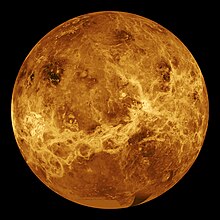List of man-made objects on Venus
The list of man-made objects on Venus includes objects that were brought from the earth to the surface of Venus . It does not contain any smaller items such as parachutes or heat shields.
While devices with a total mass of around 22 tons have been brought to Venus so far, nothing has been brought to Earth from Venus. The roughly three times the mass of objects that landed on Mars is due to the pressure of 92 bar on the surface of Venus, which requires a very solid construction of the probes. Due to the high temperatures of around 450 ° C, the previous probes only remained functional for a few hours.
The next Venus mission with Lander will not start before the year 2025 with Venera-D from Roskosmos ( Russia ) .
The objects are numbered according to the order of their impact or their landing.
| object | country | landing | Mass (kg) | position | comment | image |
|---|---|---|---|---|---|---|
| Venera 3 |
|
March 1, 1966 | 958 | unknown | Partial success, hard serve | |
| Venera 4 |
|
October 18, 1967 | 1.104 | 19 ° N, 38 ° E | Success, was able to successfully transfer data up to 15.42 miles for 96 minutes until the batteries failed (the battery life was planned to be 100 minutes). | |
| Venera 5 |
|
May 16, 1969 | 1,128 | 3 ° S, 18 ° E | Success, could be kept in contact up to an altitude of 18 kilometers above the surface of Venus for 53 minutes until it was crushed by atmospheric pressure. | |
| Venera 6 |
|
17th May 1969 | 1,128 | 5 ° S, 23 ° E | Success, contact with the lander lasted 51 minutes up to an altitude of 10 kilometers. | |
| Venera 7 |
|
December 15, 1970 | 1,180 | 5 ° S, 351 ° E | Success, sent data from the surface for 23 minutes. | |
| Venera 8 |
|
July 22, 1972 | 1,180 | 10 ° S, 335 ° E | Success, but only sent 11 seconds of data from the surface. | |
| Venera 9 |
|
October 22, 1975 | 2.015 | 32 ° N, 291 ° E | Success, sent data for 53 minutes and for the first time some images of the surface to earth. | |
| Venera 10 |
|
October 25, 1975 | 2.015 | 16 ° N, 291 ° E | Success, transmitted data and images of the surface to Earth for 63 minutes. | |
| Pioneer-Venus bus |
( NASA ) |
December 9, 1978 | 290 | 37.9 ° S, 290.9 ° E | Success, first American Venus lander. | |
| Pioneer Venus Large Probe | 300 | 4.4 ° N, 304.0 ° E | Success equipped with 7 science experiments. | |||
| Pioneer Venus Small Probe - North | 90 | 59.3 ° N, 4.8 ° E | Success, identical to the other small probes, hit the north side of the day. | |||
| Pioneer Venus Small Probe - Day | 90 | 31.3 ° S, 317.0 ° E | Success, identical to the other small probes, also hit the tag side. | |||
| Pioneer Venus Small Probe - Night | 90 | 28.7 ° S, 56.7 ° E | Success, identical to the other small probes, met on the night side. | |||
| Venera 11 |
|
December 25, 1978 | 2.015 | 14 ° S, 299 ° E | Success, transmitted data from the surface of Venus for 95 minutes. | |
| Venera 12 |
|
December 21, 1978 | 2.015 | 7 ° S, 294 ° E | Success, transmitted data from the surface of Venus for 110 minutes | |
| Venera 13 |
|
March 1, 1982 | 2.015 | 7.5 ° S, 303 ° E | Success, transmitted data from the surface of Venus for 107 minutes. | |
| Venera 14 |
|
March 3, 1982 | 2.015 | 13.25 ° S, 310 ° E | Success, transmitted data from the surface of Venus for 57 minutes. | |
| Vega 1 |
|
June 11, 1985 | 1,500 + 7 (balloon) | 7.5 ° N, 177.7 ° E | Success, transmitted data from the surface for 56 minutes. Dropped a balloon that was active in the atmosphere for 46.5 hours. | |
| Vega 2 |
|
June 14, 1985 | 1,500 + 7 (balloon) | 8.5 ° S, 164.5 ° E | Success, transmitted data from the surface for 57 minutes. Dropped a balloon that was active in the atmosphere for 60 hours. | |
| 15 missions | Total mass: | 22.6 t | ||||
See also
- List of artificial objects on other celestial bodies
- List of man-made objects on Mars
- List of man-made objects on the moon
- List of man-made objects on Mercury
Web links
- Bernd Leitenberger: Space probes for Venus and Mercury
- Pioneer Venus Project Information (English)
- Venera missions
Individual evidence
- ↑ Mike Wall: Russia, US Mulling Joint Mission to Venus. In: Space.com. January 17, 2017, accessed on November 17, 2017 (English): “It's still too early to know exactly what Venera-D will look like, what it will do or when the mission will launch. A liftoff in 2025 or 2026 is possible under an "aggressive" time line, Senske said. "It depends when the Russians can get this into their federal space budget," he said. "


